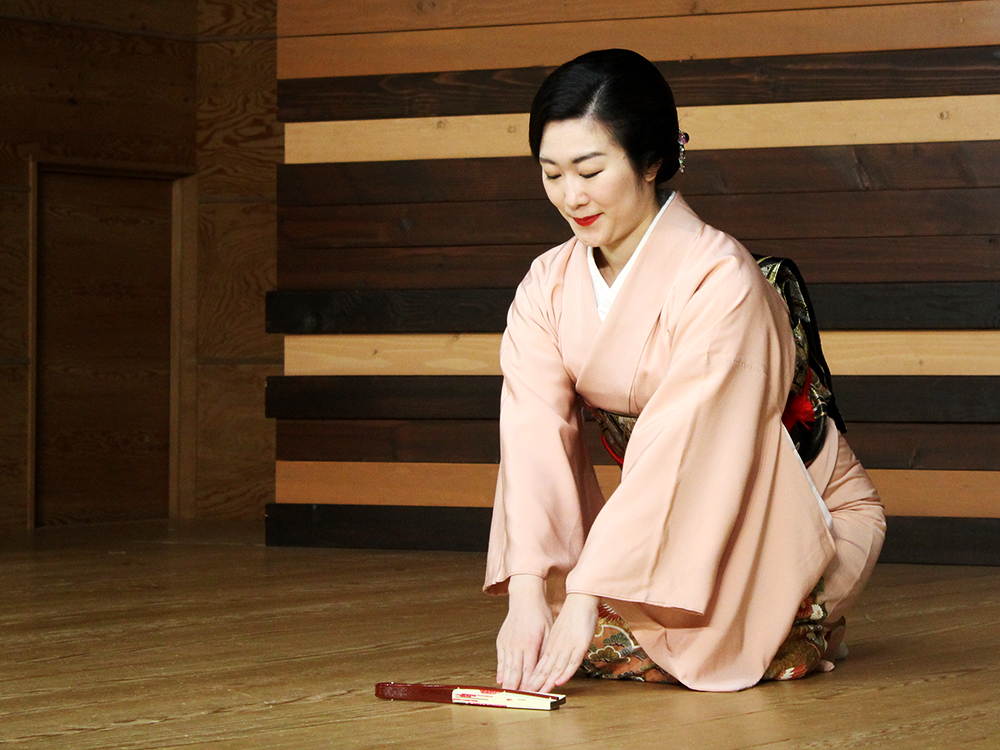We stood face to face, both of us with our feet planted at their widest widths, making me wobble like Wile E Coyote teetering on the edge of a cliff face. Whoever lost the next round had to spread their stance wider yet again, and was destined to introduce their arse to the floorboards.
“Rock, paper, scissors go!” we declared in unison… A moment’s hesitation, followed by realization: paper beats rock. Down she went, pick pastel kimono, gloriously kempt hair and all. And the crowd went wild; well at least that’s how I remember it.
I was in Hakone-Yumoto, a geisha heartland in the Fuji foothills, home to a new, modern take on one of Japan’s most famous, yet misunderstood, customs. Located in a traditional building Yumoto Kenban (formerly a geisha office), Meet Geisha holds frequent performances by some of the 150-plus working geisha in the area, offering guests the chance to experience a slight renaissance in this storied art form.
https://www.instagram.com/p/B8kunGfnFDZ/
Geisha for a Modern Age
Clad in seasonal kimono and brushed in deftly applied makeup, local geisha take to the stage to entertain culture-hungry travelers through instrumental dance routines, and classic Japanese party games like tora tora tora (rock, paper, scissors) and konpira fune fune (a rhythmic reaction-based game). Crowd participation is encouraged and translators are on hand, streamlining the experience for uninitiated guests.
On entering the lattice-fronted Yumoto Kenban, I was greeted by a thick, embroidered curtain which hung in polychromatic strips above the stage. Made from disused obi (kimono belt) silk, the curtain dominates the boxy, yet convivial, wood-panelled event space. Opting for long benches, rather than seats, which push right up to the front of the stage, the simplistic design facilitates a communal atmosphere. As do the affable resident geisha; yet being masters in the art of conversation, this should come as no surprise.
As the curtain call beckoned, Meet Geisha manager, Tamaki Nishimura, enlightened the 30-strong crowd (in English and Japanese) on the geisha custom and its roots in Hakone. Geisha have been entertaining in Hakone Yumoto since their Edo Period heyday, and now the town is second only to Kyoto in the number of these performers working in the area. Yet as the demand for tea houses has diminished, it took a rejuvenation of the geisha concept to align it with modern tastes.
https://www.instagram.com/p/B4WrVI4gll_/
The Dance of the Geisha
The event kicked off with four dance performances, each as beguiling as any other live Japanese art form. Lacking the arcana of ancient dialogue, which is part and parcel of traditional Japanese theatre, allowed the performers’ cadent movements to do the talking.
The dances were interpretative, either portraying stories from the annals of Japanese history, or digging deeper into the mythical side of its folklore. The last one was particularly striking, depicting the struggles of an old, lower class samurai and a prostitute he was endeared to.
The more masculine movements employed during the routine (representing the samurai in the tale), juxtaposed the silky yellow robe and arresting features of Sachika-san who delivered it.
https://www.instagram.com/p/B5E_iS0jm0r/
Fun and Games
Sachika-san, and fellow performer Omina-san, followed their performances by demoing old tea house party games, before ushering members of the audience up on stage to compete with them. Having, evidently, the only non-Japanese face in the room, I knew it wouldn’t be long before I was hauled up to tread the boards.
My victory over Omina-san in a bout of tora tora tora was one for the personal record books, segueing nicely into the final section of the event where the geisha fielded questions from visitors. It added an extra layer of intimacy to the experience, while they dispelled some of the conventional myths about the industry.
Having always associated geisha with the iconic ghostly white face paint, seen in almost every depiction of them, I enquired as to why their makeup looked, well, normal.
“Geisha used to wear bright white make up so that people could see us when it was dark, but we don’t need to worry about that anymore,” Sachika-san told me through Nishimura’s translation. “In fact, white face paint can look cracked and shiny in artificial light.”
More than just an interesting titbit, it seemed a sign of the modernity that Meet Geisha is trying to encourage; the archaic precepts of the geisha lifestyle are disregarded lest they have any relevance to those practicing in the 21st century. And that’s the experience in a nutshell: a distinctly modernized iteration of the geisha tradition, and one which is far more approachable for the outsider. If the classic art form is to stay relevant, this is the kind of face lift it needs.
Find more information on the Meet Geisha English website.









